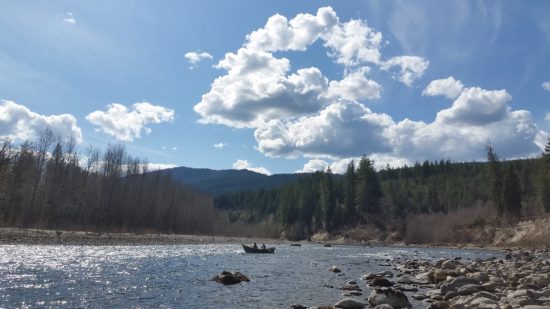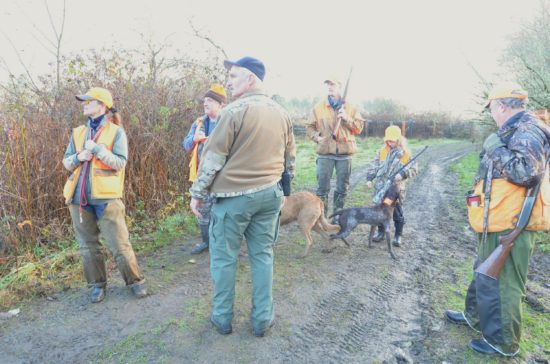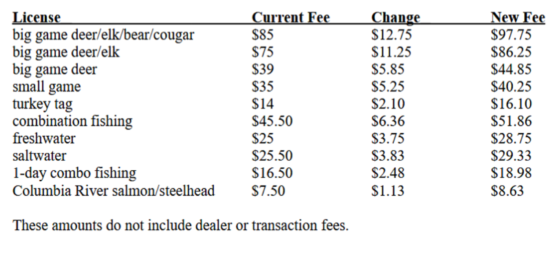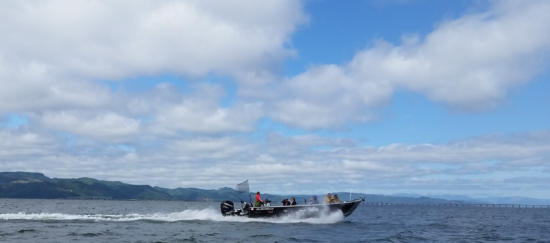
Westside Pheasant, Sound Steelheading, More At Risk Of Cuts As Lawmakers Consider WDFW Budget
Washington lawmakers are split on how to fund WDFW over the coming two years and patch up a potential $31 million shortfall.
The state House assumes the agency’s proposed fee bill passes but provides just a two-year General Fund bump to fill that gap, while the Senate would provide ongoing support from sales taxes but doesn’t raise the cost of fishing and hunting licenses.

The legislative session is scheduled to wrap up April 28, and while extra time in Olympia has become routine in recent years, WDFW brass are increasingly nervous as they eye the gulfs between the two chambers’ spending proposals for the 2019-21 biennium and have to consider cutting more popular programs.
“Each day that passes, we become a little more anxious,” said policy director Nate Pamplin on Tuesday.
Last Friday, his boss, Director Kelly Susewind, warned the Fish and Wildlife Commission that the Senate’s budget approach could lead to “some pretty devastating potential cuts for us.”
“The lack of a fee bill really hurts the fishing and hunting side of the agency pretty hard,” Morgan Stinson, WDFW’s budget director, said yesterday.
On the fishing side of the fillet board are federally required monitoring of the last early winter steelheading opportunities on Puget Sound rivers and on the Skagit-Sauk in spring; the closure of Reiter, Whitehorse, Naches, Chelan and Meseberg hatcheries, which together produce 2.6 million steelhead, salmon and trout; rehabbing lakes for better trout fishing; and a brutal whack at the warmwater program.

“The lower priorities fall off because we don’t have any low priorities. They’re low among all high — these are the lowest highs,” Susewind told members of the commission.
Over on the hunting side, the Master Hunter program, which the state uses to manage problem animals with the help of select sportsmen, would end, as would the Western Washington pheasant program.
Like largemouth, ringnecks are also nonnative, putting them on the wrong end of the list, but Pamplin added that the cost to raise and release the birds at Westside wildlife areas also exceeds the revenues the hunting opportunity brings in.

“If we bring in 15 percent more revenue, maybe we can restore it,” he said.
Fifteen percent is how much WDFW’s across-the-board fee hike would cost hunters and anglers, but with a $7 cap on bundled license packages, a caveat that came from the Fish and Wildlife Commission.
It would be the first license increase since 2011 and is meant in part to shore up the shortfall and maintain opportunities.

The agency’s budget woes are primarily due to our license revenues not keeping up with costs to produce fish and manage critters and seasons; the Great Recession, which chopped its state General Fund stake from $110 million in 2007-09 to as low as $57.7 million in 2011-13 (with a one-time $10 million infusion for the current budget it grew back to $94.4 million); and inflation over the years.
Stinson said that WDFW’s structural deficit — how much lawmakers says it can spend versus how much money it actually takes in — is around $31 million this biennium.
APRIL 5, 2019 WDFW COMPARISON OF GOV. INSLEE, STATE HOUSE AND SENATE BUDGETS (FIGURES ARE IN MILLIONS)
Maintain/ Buy-back Decision Packages Gov House Senate Maintain wildlife conflict response $4.4 $4.4 $4.4 Maintain public health and safety, Shellfish $2.5 $2.5 $2.5 Maintain land management $2.6 $2.6 $2.6 Maintain fishing and hatchery production $9.4 $9.4 $3.7 Maintain hunting $3.1 $3.1 – Maintain conservation $3.4 $3.4 $3.4 Maintain Columbia River salmon and steelhead endorsement $3.0 $3.0 – Maintain customer service $1.9 $1.9 $1.9
Enhancement Decision Packages Gov House Senate Enhance conservation $1.3 $0.6 – Enhance hunting and conflict response $0.8 – – Enhance fishing $6.9 $2.6 – Lands enhancement – – – Enhance Regional Fishery Enh. Groups $0.7 – $0.7
|
|
|
|
|
|
|
|
|
|
|
|
|
|
|
|
|
|
|
|
|
|
|
|
|
|
|
|
|
|
|
|
|
|
|
|
|
|
|
|
|
|
|
|
|
|
|
|
Without the fee bill, hunter education, private lands access and game management would also be reduced, WDFW warns.
And while extending the important Columbia salmon and steelhead endorsement is part of the House budget, it’s not in the Senate’s, and that could impact the agency’s ability to hold and monitor fisheries on the big river.
Now, no doubt that WDFW warning its constituents about such dire cuts to programs is meant in part to spur hunters and anglers to contact their lawmakers to try and head things off, but on the flip side it will also just stir an already buzzing hornet’s nest of sportsman angst and anger towards it.
“They’re upset at us for a number of reasons, like they always are,” Director Susewind told the commission last week about the Columbia endorsement, “but this would actually make us less able to deliver the things they’re upset at us for not having more of.”
“Upset” might be a bit of an understatement.
WDFW’s fee bill in the Senate is caught tighter than a salmon in a gillnet over management issues on the big river.
In early March, the Fish and Wildlife Commission paused ongoing Columbia fishery reforms for 2019, voting to continue allowing nontribal gillnetting below Bonneville (phaseout had been planned by 2017), and reducing sportfishing ESA impact allocations on spring and summer Chinook from 80-20 to 70-30 (though the lower figure applies only if there are enough springers this year after a run update).
That infuriated longtime supporters of the reforms and efforts to end gillnetting in the Northwest, especially as it followed on the death of a Senate bill that would have barred the nontreaty commercial practice on the river in a couple years.

The Northwest Sportfishing Industry Association called on members to oppose WDFW’s fee bill, claiming the commission vote “restores year-round non-tribal gillnetting on the Columbia River’s 13 ESA listed stocks.”
According to ODFW and WDFW documents, there were four days of nontribal gillnetting for salmon on the mainstem last year. Those occurred in late August and targeted fall Chinook between Bonneville and the mouth of the Lewis. Low runs are expected to continue this year, making for limited fishing opportunities for all fleets.
Asked how the gillnet vote has impacted the fee bill, Pamplin acknowledged that it’s one of those big issues that always pops up each session.
“We have heard from legislators about concerns with the Columbia and the fee bill,” he said.
But he also pointed back to WDFW’s Budget and Policy Group of “opinion leaders” in the state fish and wildlife world and said that despite their own issues — “wolves, carnivores, hatcheries, allocations” — they “pretty quickly” saw a “healthy funded” agency was necessary, and some members continue to push for lawmakers to fully fund it.
BPAG came out of a 2017 legislative requirement that WDFW review its funding and operations.
It included an agency audit that found WDFW’s money problems weren’t due to mismanagement. And it mandated a zero-based budgeting exercise, which Pamplin said prioritized native species over nonnative ones, thus the warmwater and pheasant programs being proposed for cuts.
“But we recognize the value” of bass and other species, Pamplin quickly added. “We don’t want to cut it.”
And before last year asking for an overall $60-plus million fee hike and General Fund increase to maintain and enhance opportunties, WDFW also trimmed $2 million, affecting a number of IT positions, reduced grant funding, and triploid trout stocking.

Elsewhere in legislators’ proposed 2019-21 budgets, the House makes a “really strong investment” for orcas with $14.8 million for additional hatchery salmon production, “one of the most important near-term fixes as we work on culverts,” in WDFW’s words.
Senate support for clipped fish isn’t as high, but members are taking a bit more of a regulatory approach for getting more Chinook to the southern residents, focusing on shoreline armoring, vessel distance and regulating the whale-watching industry, Pamplin said.
Now, as budget negotiations begin in earnest, WDFW staffers are reaching out to lawmakers, highlighting what could be impacted in their districts, and trying to make recommendations to each chamber about what a compromise might look like.
“What we’re focusing on right now is contacting legislators to walk through the difference between both budgets,” says Pamplin.
How that plays out will determine what gets cut and what gets saved in the coming two years and probably longer.
